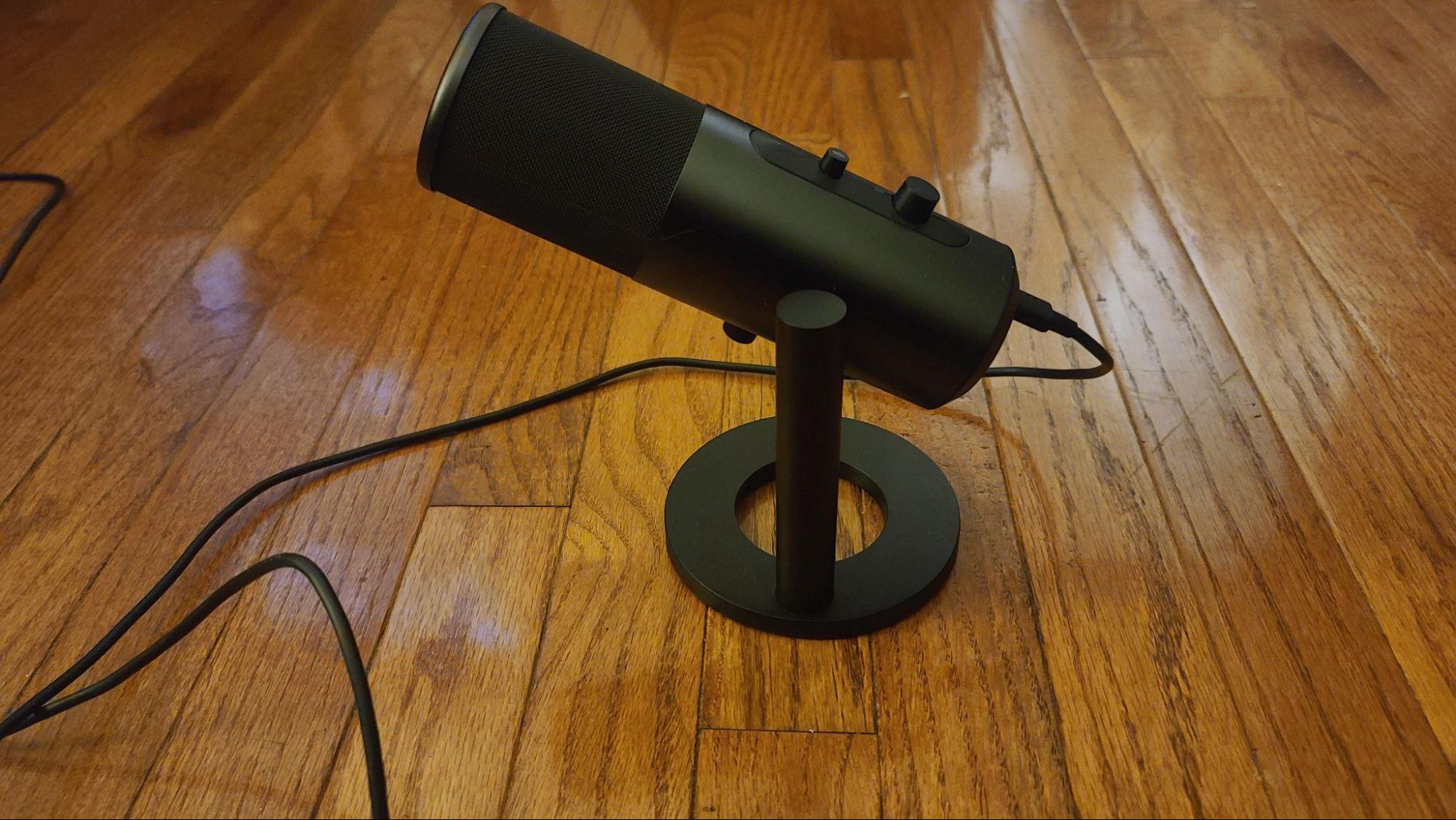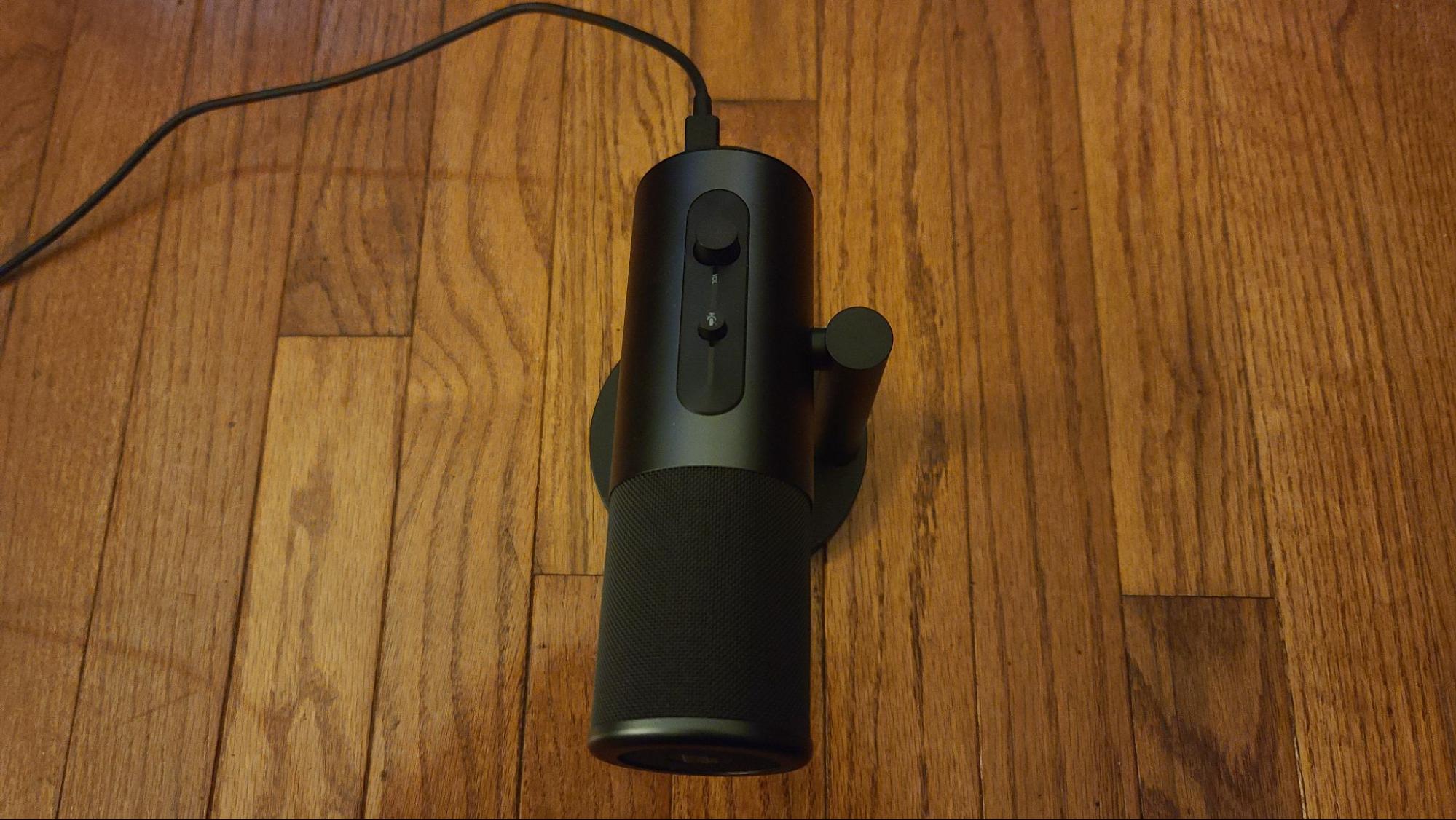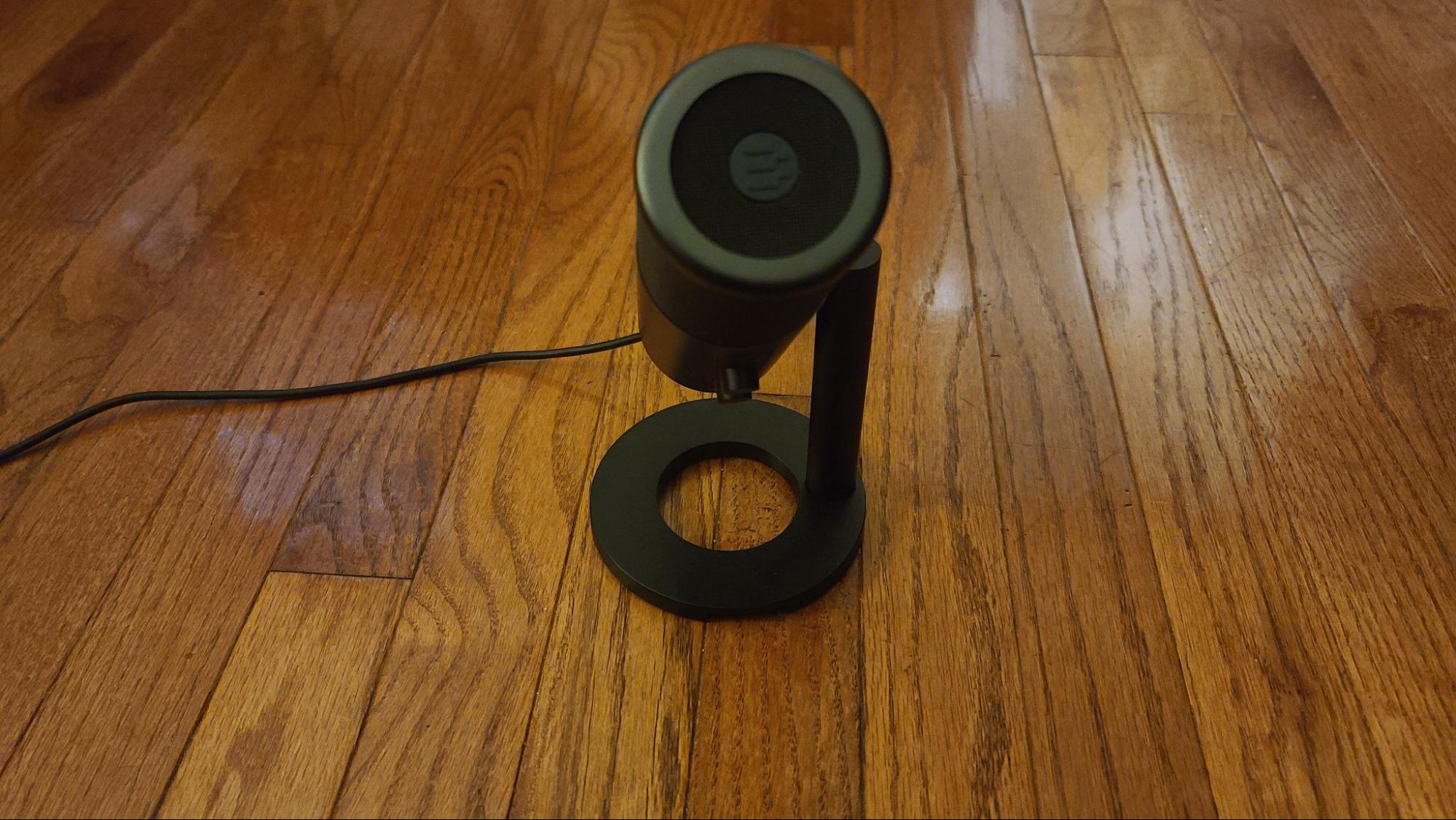Tom's Hardware Verdict
The Epos B20 is a solidly-constructed, professional-grade microphone that comes close to justifying its hefty price tag, but makes it too difficult to tell what your gain is.
Pros
- +
+ Superb, natural sound
- +
+ Conveniently mounts to a boom arm with standard threads
- +
+ A wide variety of pickup pattern options
- +
+ Excellent build quality
Cons
- -
Feels wobbly and loose on its desktop stand
- -
Gain knob lacks useful user feedback
- -
The Stereo pickup setting sounds muffled
- -
Expensive
Why you can trust Tom's Hardware
The Epos B20 provides a true plug and play experience. Everything you need to get this microphone up and running is in the package, no software setup necessary. The mic easily mounts to the included desktop stand with a single thumbscrew and can attach to any standard boom arm without the need for a mounting adapter. Its sleek, black metal housing also makes it look at home in a variety of setups.
The $199 B20 sounds great out of the box and offers a variety of pickup pattern options to satisfy most use cases, but the Stereo pickup setting’s lackluster sound and counterintuitive gain controls stand out as obstacles keeping it from being one of the best gaming microphones.
Epos B20 Specs
| Frequency Response Range | 50 - 20000 Hz |
| Sample / Bitrate | 48 kHz / 24-bit |
| Polar Patterns | Cardioid, Stereo, Omnidirectional, Bidirectional |
| Headphone Amplifier Impedance | 15 Ohms |
| Dimensions (extended in stand, LxWxH) | 180.086 x 103.886 x 103.886 mm / 7.09 x 4.09 x 10.83 inches |
| Weight | Mic & Included U-Mount - 39.68 (1124.909 g), Base |
| Extra | Desktop Stand |
Design of Epos B20



The Epos B20 Microphone is a hefty beast, coming in an almost 11 inch tall cylindrical metal capsule that looks more like a broadcast mic than a gaming peripheral. The grille protecting the condenser feels nearly as solid as the capsule itself, offering very little give, even with a tight squeeze. I/O is kept simple, with a USB-C connector and a 3.5mm jack for direct monitoring located on the rear of the capsule.
The control layout consists of a microphone mute button and monitor volume wheel on the top side of the capsule, with the gain knob and four-way pickup pattern selector located on the underside. The mute button has a helpful LED indicator that glows white when the mic is active and red when it is muted. It would have been helpful for Epos to have included similar indicator lights for the volume and gain controls.
The Epos B20 comes attached to a pivot arm that can be mounted to the included base stand with the thumbscrew in the package or to a boom via the standard threads with no additional mounting equipment required. This is a very nice touch and makes setup quick and painless. If there’s one complaint I do have, it’s that the desktop mount doesn’t feel balanced – the mic capsule and its attached pivot arm are on the heavy side and the ring-shaped desktop stand can wobble slightly under the weight. This is particularly noticeable when making adjustments to mic position – it is often necessary to hold the base in place lest your attempts to set the microphone to a better angle move the entire unit. A thicker base mount that utilizes the same threads as a boom arm mount would have perhaps been a more convenient and solid design choice.
Overall, the Epos B20 strikes a nice balance between simplicity, premium construction and convenience while staying away from the gaudy aesthetics that typify gaming gear.
Sound Quality of Epos B20
The Epos B20 offers superb sound quality with a wide frequency response that enables accurate voice reproduction – bass frequencies were rich and round without sounding boomy, mids cut through without emphasizing an annoying honkiness and highs were crisp and clear without harshness or sibilance. The tonality of the Epos B20 is nicely balanced without sounding overly compressed. There’s a warmth to it that can be heard on recordings that is pleasing to the ear. The base tone of the mic is quite impressive and a cut above most gaming grade peripherals.
Get Tom's Hardware's best news and in-depth reviews, straight to your inbox.
The Epos B20 gives users a choice between four pickup patterns. This is nice for situational versatility but not all settings are equal in terms of their utility. The Cardioid and Omnidirectional notches on the dial yielded the best results when using the B20 as a desktop mic, offering balanced tone and minimal ambient noise pickup. There is a noticeable difference in input gain sensitivity between the two, with the Omnidirectional setting being a bit on the hotter side and not as good at keeping room noise out of your recordings and broadcasts.
The Bidirectional pattern is the hottest notch on the dial and is best used if the B20 is mounted to a boom – keyboard chatter and other competing sounds can register just as loud as your voice if you’re using this pickup pattern with your mic sitting on your desk. Keep in mind when switching pickup patterns that the hotter your input signal is, the more you will have to dial back the gain on the mic to compensate and prevent clipping. All three of these settings have their advantages depending on your use case but the Stereo pickup setting is a bit of a head scratcher.
With Stereo selected, there was a highly noticeable drop in input gain as well as overall clarity and the ambient noise levels rose from barely perceptible to extremely annoying. Unless you’re a fan of broadcasts that sound like they were recorded with a wall of pillows covering the microphone, the stereo setting is best avoided altogether.
The Epos B20 needs very little tweaking to sound great in a mix, but getting there can be a little problematic at times. Apart from using a spare set of headphones as in-ear monitors prior to broadcast or carefully eyeballing the output fader level on your streaming or recording software, there’s really no way to intuitively know how your input gain is set. A notched dial or an LED to indicate how hot the mic is would be very helpful, but Epos instead gave us a smooth, infinitely scrolling gain dial that offers no visual or tactile feedback. Having a rough idea of how your input gain is set shouldn’t require software or external in ear monitors.
Features and Software of Epos B20
The Epos B20 is designed with simplicity in mind – there is no software package to download, meaning the user will need to rely on their preferred streaming software to set levels and monitor input gain for the mic. This is where the addition of some kind of LED indicator on the mic itself would have been handy. Apart from checking your output levels in third party software or via direct monitoring, there’s really no way to tell how you’ve set your gain.
Bottom Line
The Epos B20 looks and sounds like a professional broadcast microphone, offering excellent build quality, attractive design, convenient mounting options and superior sound reproduction, but it does have some significant flaws that may make its $199 price tag difficult to swallow for some.
The included desktop stand is a little on the light side for the hefty B20, causing the entire unit to shift when making adjustments to the mic angle. The pivot arm also feels wobbly and loose when mounted to the desktop stand.
Most of the pickup patterns sound excellent but the Stereo setting leaves a lot to be desired. With the Stereo pickup pattern selected, the B20 sounds muffled and background noise becomes much tougher to control. It may be better to avoid using the Stereo setting at all unless you have time for extensive tweaking in post.
Perhaps the most frustrating issue with the B20 lies with its gain knob. Instead of opting for a dial that gives the user a clear indication of where their level is set, Epos has outfitted the B20 with a knob that smoothly sweeps infinitely in both directions. An LED indicator or, at the very least, a notched dial would have been very helpful. Without any visual or tactile user feedback, in ear monitoring and careful study of the input signal readout in streaming software is essential to avoid clipping.
It’s great that Epos offers an extremely well built, great sounding and conveniently designed ( loved not needing additional parts to mount the unit to a boom) mic in the B20, but pricing it at $199 is a little difficult to justify in a field crowded with high quality options. The B20 is an excellent choice for a plug and play, broadcast quality mic solution but the Rode NT Mini is also a great option for half the price. Hyper X’s Quantcast S offers a similar form factor and multiple pickup pattern options for $50 less – plus you get RGB lighting if that’s something you want. While the B20 is a superb mic in its own right, its pricing means we can only recommend it hesitantly rather than with complete enthusiasm.

Nate Rand is a freelance reviewer for Tom's Hardware US, covering gaming headsets, keyboards, mice, and microphones.